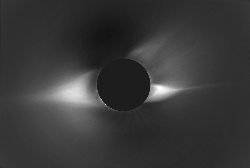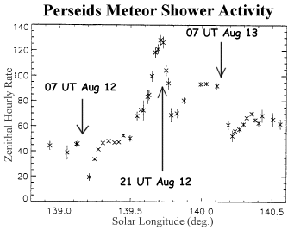Table showing how many meteors will be seen per hour.
Click on image for full size
Courtesy of NASA
Watch Out for the Meteors!
News story originally written on August 10, 1999
This week's solar eclipse isn't the only thing to watch! The Perseid meteor shower will peak on August 12-13, 1999. There could be as many as 150 "shooting stars" per hour. The best time to look is very early in the morning.
Meteors are small pieces of dust and ice that break off a comet. They are about the size of a grain of sand. They look so bright because they burn up in Earth's atmosphere.
The best way to see the shower is to lie on your back facing north. It will look like the meteors are coming from the constellation Perseus. If you live in the Northern Hemisphere you can watch the shower. But if you live in the Southern Hemisphere, you will have to watch it on the web. NASA will show it live on the link below!
You might also be interested in:

The last solar eclipse of this millennium was on August 11, 1999. Only people in Europe, the Middle East and India could see it. This was a total solar eclipse, which means that the Moon completely blocked
...more
It was another exciting and frustrating year for the space science program. It seemed that every step forward led to one backwards. Either way, NASA led the way to a great century of discovery. Unfortunately,
...more
The Space Shuttle Discovery lifted off from Kennedy Space Center on October 29th at 2:19 p.m. EST. The sky was clear and the weather was great. This was the America's 123rd manned space mission. A huge
...more
Scientists found a satellite orbiting the asteroid, Eugenia. This is the second one ever! A special telescope allows scientists to look through Earth's atmosphere. The first satellite found was Dactyl.
...more
The United States wants Russia to put the service module in orbit! The module is part of the International Space Station. It was supposed to be in space over 2 years ago. Russia just sent supplies to the
...more
A coronal mass ejection (CME) happened on the Sun last month. The material that was thrown out from this explosion passed the ACE spacecraft. ACE measured some exciting things as the CME material passed
...more
Trees and plants are a very important part of this Earth. Trees and plants are nature's air conditioning because they help keep our Earth cool. On a summer day, walking bare-foot on the sidewalk burns,
...more















